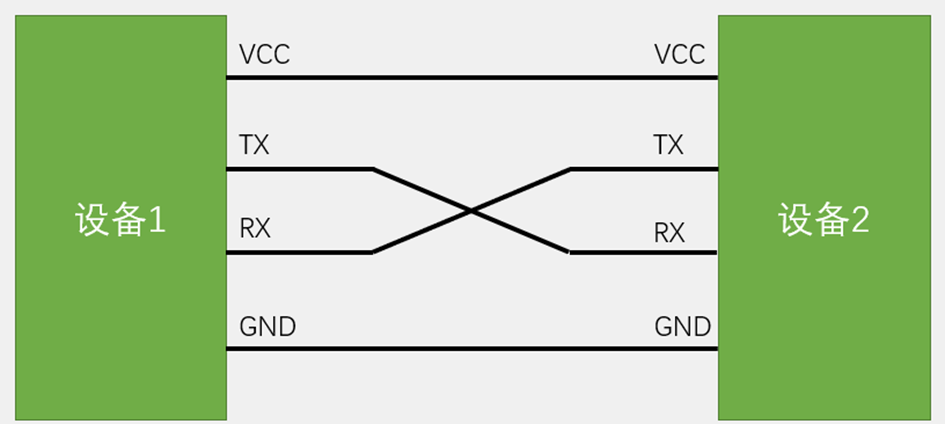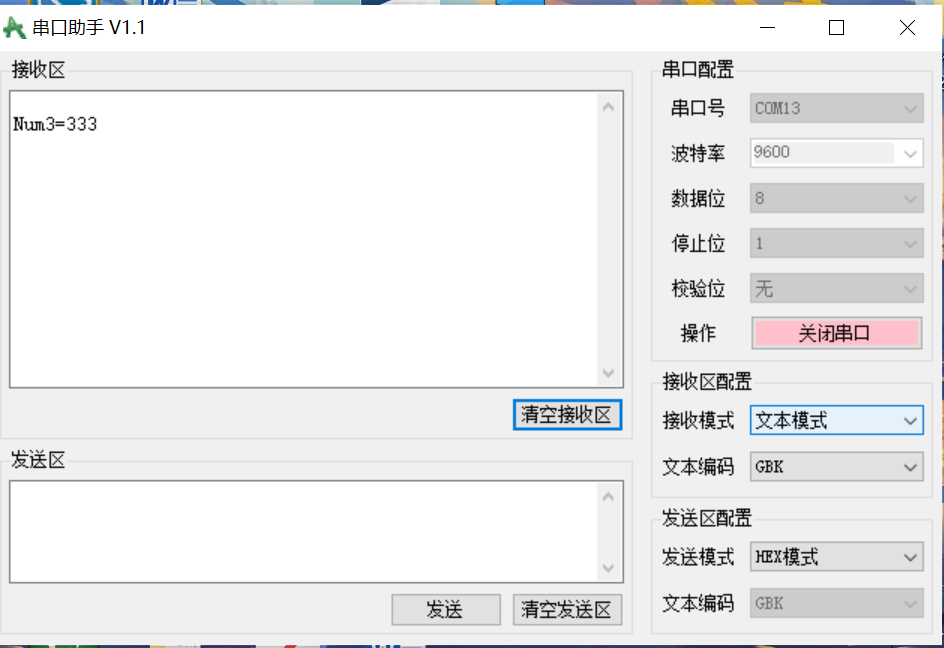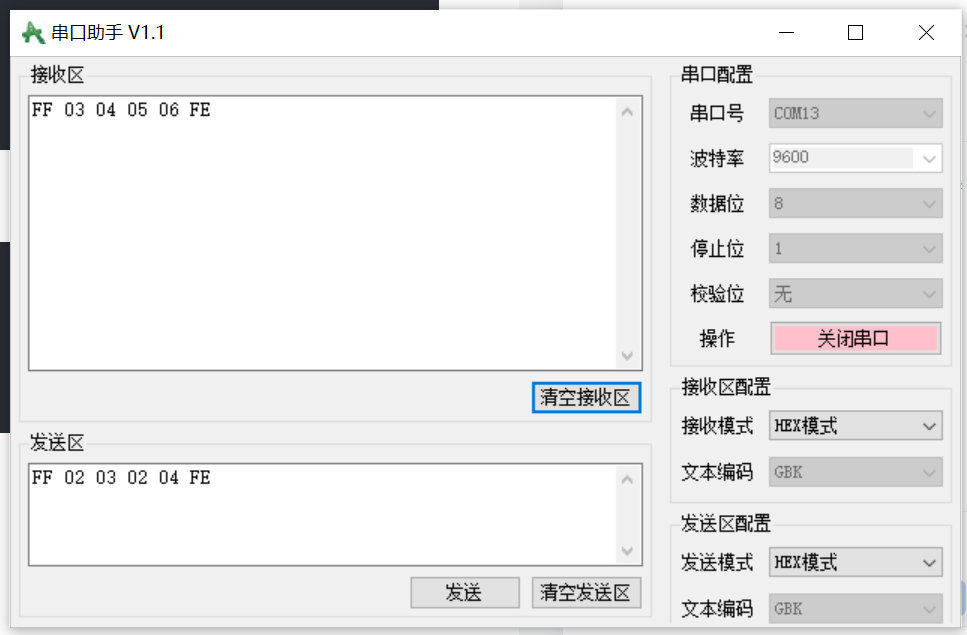3.1 电脑端接收数据(单片机发送)
(1)、Serial.c
cpp
#include "stm32f10x.h" // STM32F1系列标准库头文件
#include <stdio.h> // 标准输入输出库(支持fputc函数)
#include <stdarg.h> // 可变参数库(支持Serial_Printf的...参数)
/**
* @brief 串口初始化函数(USART1,仅发送模式)
* @param 无
* @retval 无
* @note 配置参数:9600波特率、8位数据位、1位停止位、无奇偶校验、无硬件流控
* 硬件引脚:USART1_TX -> PA9(复用推挽输出)
*/
void Serial_Init(void)
{
// 1. 使能相关外设时钟(USART1时钟 + GPIOA时钟)
RCC_APB2PeriphClockCmd(RCC_APB2Periph_USART1, ENABLE); // 使能USART1外设时钟(APB2总线)
RCC_APB2PeriphClockCmd(RCC_APB2Periph_GPIOA, ENABLE); // 使能GPIOA时钟(PA9为USART1_TX引脚)
// 2. 配置TX引脚(PA9)为复用推挽输出模式
GPIO_InitTypeDef GPIO_InitStructure; // GPIO初始化配置结构体
GPIO_InitStructure.GPIO_Mode = GPIO_Mode_AF_PP; // 复用推挽输出(串口TX需用复用模式)
GPIO_InitStructure.GPIO_Pin = GPIO_Pin_9; // 配置PA9引脚
GPIO_InitStructure.GPIO_Speed = GPIO_Speed_50MHz; // GPIO输出速度50MHz
GPIO_Init(GPIOA, &GPIO_InitStructure); // 将配置应用到GPIOA端口
// 3. 配置USART1串口参数
USART_InitTypeDef USART_InitStructure; // USART初始化配置结构体
USART_InitStructure.USART_BaudRate = 9600; // 波特率:9600bps(每秒传输9600位)
USART_InitStructure.USART_HardwareFlowControl = USART_HardwareFlowControl_None; // 无硬件流控(不使用CTS/RTS引脚)
USART_InitStructure.USART_Mode = USART_Mode_Tx; // 工作模式:仅发送(Tx),若需接收则设为USART_Mode_Tx | USART_Mode_Rx
USART_InitStructure.USART_Parity = USART_Parity_No; // 无奇偶校验位(数据帧无校验位)
USART_InitStructure.USART_StopBits = USART_StopBits_1; // 1位停止位(数据帧结束标志)
USART_InitStructure.USART_WordLength = USART_WordLength_8b; // 8位数据位(每个数据帧包含8位有效数据)
USART_Init(USART1, &USART_InitStructure); // 将配置应用到USART1外设
// 4. 使能USART1外设(串口初始化完成后,启用串口)
USART_Cmd(USART1, ENABLE);
}
/**
* @brief 串口发送单个字节
* @param Byte:要发送的8位无符号字节(范围:0~255)
* @retval 无
* @note 阻塞式发送:发送前等待发送数据寄存器为空,确保数据可靠发送
*/
void Serial_SendByte(uint8_t Byte)
{
// 将字节写入USART1发送数据寄存器(TDR),硬件自动通过TX引脚发送
USART_SendData(USART1, Byte);
// 等待发送完成:查询TXE标志位(发送数据寄存器空)
// TXE=RESET:数据未发送完成,继续等待;TXE=SET:数据已发送,寄存器空
while (USART_GetFlagStatus(USART1, USART_FLAG_TXE) == RESET);
}
/**
* @brief 串口发送字节数组
* @param Array:要发送的字节数组首地址(指针)
* @param Length:数组长度(要发送的字节个数)
* @retval 无
* @note 循环调用Serial_SendByte,逐个发送数组元素,阻塞式发送
*/
void Serial_SendArray(uint8_t *Array, uint16_t Length)
{
uint16_t i;
// 遍历数组,逐个发送每个字节
for(i = 0; i < Length; i++)
{
Serial_SendByte(Array[i]); // 调用单字节发送函数
}
}
/**
* @brief 串口发送ASCII字符串
* @param String:要发送的字符串首地址(指针)
* @retval 无
* @note 以'\0'(ASCII码0)为字符串结束标志,自动遍历发送所有字符
*/
void Serial_SendString(char *String)
{
uint8_t i;
// 循环发送,直到遇到字符串结束符'\0'
for(i = 0; String[i] != 0; i++)
{
Serial_SendByte(String[i]); // 每个字符本质是8位ASCII码,调用单字节发送
}
}
/**
* @brief 幂运算辅助函数(计算x的y次方)
* @param x:底数(如10)
* @param y:指数(如3,表示x^3)
* @retval 计算结果(x^y)
* @note 仅支持非负整数幂,用于Serial_SendNumber拆分数字每一位
*/
uint32_t Serial_Pow(uint32_t x, uint32_t y)
{
uint32_t Result = 1; // 结果初始值为1(任何数的0次方为1)
while(y--) // 循环y次,每次结果乘以x
{
Result *= x;
}
return Result; // 返回x^y的结果
}
/**
* @brief 串口发送无符号整数(转换为ASCII字符发送)
* @param Number:要发送的无符号整数(范围:0~4294967295)
* @param Length:要发送的数字位数(不足位数补前导0,超出位数截断高位)
* @retval 无
* @example Serial_SendNumber(123, 3) → 发送'1'、'2'、'3';Serial_SendNumber(45, 4) → 发送'0'、'0'、'4'、'5'
*/
void Serial_SendNumber(uint32_t Number, uint8_t Length)
{
uint8_t i;
// 遍历每一位,从高位到低位发送
for(i = 0; i < Length; i++)
{
// 核心逻辑:拆分数字每一位并转换为ASCII码
// 1. Number / Serial_Pow(10, Length-i-1):获取当前位的高位数值(如123/100=1)
// 2. %10:提取当前位数字(如1%10=1)
// 3. +0x30:转换为ASCII码(0~9对应ASCII码0x30~0x39)
Serial_SendByte(Number / Serial_Pow(10, Length - i - 1) % 10 + 0x30);
}
}
/**
* @brief 重定向C标准库fputc函数(底层支撑printf串口输出)
* @param ch:要发送的字符(ASCII码值)
* @param f:标准库文件指针(兼容接口,无实际作用)
* @retval ch:返回发送的字符(符合fputc函数标准接口要求)
* @note 调用printf时,printf会自动循环调用fputc发送每个字符,此函数将字符转发到串口
*/
int fputc(int ch, FILE *f)
{
Serial_SendByte(ch); // 将fputc的字符通过串口发送
return ch; // 返回发送的字符,确保printf正常工作
}
/**
* @brief 自定义格式化串口输出函数(类似printf,不依赖标准库也可使用)
* @param format:格式化字符串(含占位符,如%d、%s、%x等)
* @param ...:可变参数(对应format中的占位符,数量可变)
* @retval 无
* @example Serial_Printf("数值:%d,字符串:%s\r\n", 123, "Hello") → 发送格式化字符串
*/
void Serial_Printf(char *format, ...)
{
char String[100]; // 缓存拼接后的完整字符串(最多支持99个有效字符)
va_list arg; // 可变参数列表指针(用于解析...中的参数)
va_start(arg, format); // 初始化可变参数列表,绑定到format后
// 将格式化字符串+可变参数拼接为完整字符串,存入String数组
vsprintf(String, format, arg); // vsprintf支持可变参数格式化
va_end(arg); // 结束可变参数解析
Serial_SendString(String); // 发送拼接后的完整字符串
}(2)、Serial.h
cpp
#ifndef __SERIAL_H
#define __SERIAL_H
#include <stdio.h>
void Serial_Init(void);
void Serial_SendByte(uint8_t Byte);
void Serial_SendArray(uint8_t *Array, uint16_t Length);
void Serial_SendString(char *String);
void Serial_SendNumber(uint32_t Number, uint8_t Length);
void Serial_Printf(char *format, ...);
#endif(3)、main.c
cpp
#include "stm32f10x.h" // Device header
#include "Delay.h"
#include "Serial.h"
#include <stdio.h>
#include <stdarg.h>
int main(void)
{
Serial_Init();
// Serial_SendByte(0x41);
//
//
// uint8_t MyArray[] = {0x42, 0x43, 0x44, 0x45};
// Serial_SendArray(MyArray, 4);
// Serial_SendString("\r\nNum1=");
// Serial_SendNumber(111, 3);
//
// printf("\r\nNum2=%d", 222);
char String[100];
sprintf(String, "\r\nNum3=%d", 333);
Serial_SendString(String);
// Serial_Printf("\r\nNum4=%d", 444);
// Serial_Printf("\r\n");
while (1)
{
}
}注意事项:
串口通信时,要注意选择文本模式还是hex模式
串口助手的波特率不要选错。端口(USB-SERIAL-CH340)不要选错。
线不要插错(特别是TX、RX要交叉连接)。
· 是否有接收到数据,可以看USB转TTL模块外设的灯有没有闪烁。
记得打开串口助手中的打开串口
记得给小车复位

程序运行结果:

3.2 串口收发数据
(1)、main.c
cpp
#include "stm32f10x.h" // Device header
#include "Delay.h"
#include "Serial.h"
uint8_t RxData; //定义用于接收串口数据的变量
int main(void)
{
/*串口初始化*/
Serial_Init(); //串口初始化
// 发送数据给32
// Serial_SendString("Hello STM32!\r\n");
while (1)
{
if (Serial_GetRxFlag() == 1) //检查串口接收数据的标志位
{
RxData = Serial_GetRxData(); //获取串口接收的数据
Serial_SendByte(RxData); //串口将收到的数据回传回去,用于测试
}
}
}(2)、Serial.c
cpp
#include "stm32f10x.h" // Device header
#include <stdio.h>
#include <stdarg.h>
uint8_t Serial_RxData; //定义串口接收的数据变量
uint8_t Serial_RxFlag; //定义串口接收的标志位变量
/**
* 函 数:串口初始化
* 参 数:无
* 返 回 值:无
*/
void Serial_Init(void)
{
/*开启时钟*/
RCC_APB2PeriphClockCmd(RCC_APB2Periph_USART1, ENABLE); //开启USART1的时钟
RCC_APB2PeriphClockCmd(RCC_APB2Periph_GPIOA, ENABLE); //开启GPIOA的时钟
/*GPIO初始化*/
GPIO_InitTypeDef GPIO_InitStructure;
GPIO_InitStructure.GPIO_Mode = GPIO_Mode_AF_PP;
GPIO_InitStructure.GPIO_Pin = GPIO_Pin_9;
GPIO_InitStructure.GPIO_Speed = GPIO_Speed_50MHz;
GPIO_Init(GPIOA, &GPIO_InitStructure); //将PA9引脚初始化为复用推挽输出
GPIO_InitStructure.GPIO_Mode = GPIO_Mode_IPU;
GPIO_InitStructure.GPIO_Pin = GPIO_Pin_10;
GPIO_InitStructure.GPIO_Speed = GPIO_Speed_50MHz;
GPIO_Init(GPIOA, &GPIO_InitStructure); //将PA10引脚初始化为上拉输入
/*USART初始化*/
USART_InitTypeDef USART_InitStructure; //定义结构体变量
USART_InitStructure.USART_BaudRate = 9600; //波特率
USART_InitStructure.USART_HardwareFlowControl = USART_HardwareFlowControl_None; //硬件流控制,不需要
USART_InitStructure.USART_Mode = USART_Mode_Tx | USART_Mode_Rx; //模式,发送模式和接收模式均选择
USART_InitStructure.USART_Parity = USART_Parity_No; //奇偶校验,不需要
USART_InitStructure.USART_StopBits = USART_StopBits_1; //停止位,选择1位
USART_InitStructure.USART_WordLength = USART_WordLength_8b; //字长,选择8位
USART_Init(USART1, &USART_InitStructure); //将结构体变量交给USART_Init,配置USART1
/*中断输出配置*/
USART_ITConfig(USART1, USART_IT_RXNE, ENABLE); //开启串口接收数据的中断
/*NVIC中断分组*/
NVIC_PriorityGroupConfig(NVIC_PriorityGroup_2); //配置NVIC为分组2
/*NVIC配置*/
NVIC_InitTypeDef NVIC_InitStructure; //定义结构体变量
NVIC_InitStructure.NVIC_IRQChannel = USART1_IRQn; //选择配置NVIC的USART1线
NVIC_InitStructure.NVIC_IRQChannelCmd = ENABLE; //指定NVIC线路使能
NVIC_InitStructure.NVIC_IRQChannelPreemptionPriority = 1; //指定NVIC线路的抢占优先级为1
NVIC_InitStructure.NVIC_IRQChannelSubPriority = 1; //指定NVIC线路的响应优先级为1
NVIC_Init(&NVIC_InitStructure); //将结构体变量交给NVIC_Init,配置NVIC外设
/*USART使能*/
USART_Cmd(USART1, ENABLE); //使能USART1,串口开始运行
}
/**
* 函 数:串口发送一个字节
* 参 数:Byte 要发送的一个字节
* 返 回 值:无
*/
void Serial_SendByte(uint8_t Byte)
{
USART_SendData(USART1, Byte); //将字节数据写入数据寄存器,写入后USART自动生成时序波形
while (USART_GetFlagStatus(USART1, USART_FLAG_TXE) == RESET); //等待发送完成
/*下次写入数据寄存器会自动清除发送完成标志位,故此循环后,无需清除标志位*/
}
/**
* 函 数:串口发送一个数组
* 参 数:Array 要发送数组的首地址
* 参 数:Length 要发送数组的长度
* 返 回 值:无
*/
void Serial_SendArray(uint8_t *Array, uint16_t Length)
{
uint16_t i;
for (i = 0; i < Length; i ++) //遍历数组
{
Serial_SendByte(Array[i]); //依次调用Serial_SendByte发送每个字节数据
}
}
/**
* 函 数:串口发送一个字符串
* 参 数:String 要发送字符串的首地址
* 返 回 值:无
*/
void Serial_SendString(char *String)
{
uint8_t i;
for (i = 0; String[i] != '\0'; i ++)//遍历字符数组(字符串),遇到字符串结束标志位后停止
{
Serial_SendByte(String[i]); //依次调用Serial_SendByte发送每个字节数据
}
}
/**
* 函 数:次方函数(内部使用)
* 返 回 值:返回值等于X的Y次方
*/
uint32_t Serial_Pow(uint32_t X, uint32_t Y)
{
uint32_t Result = 1; //设置结果初值为1
while (Y --) //执行Y次
{
Result *= X; //将X累乘到结果
}
return Result;
}
/**
* 函 数:串口发送数字
* 参 数:Number 要发送的数字,范围:0~4294967295
* 参 数:Length 要发送数字的长度,范围:0~10
* 返 回 值:无
*/
void Serial_SendNumber(uint32_t Number, uint8_t Length)
{
uint8_t i;
for (i = 0; i < Length; i ++) //根据数字长度遍历数字的每一位
{
Serial_SendByte(Number / Serial_Pow(10, Length - i - 1) % 10 + '0'); //依次调用Serial_SendByte发送每位数字
}
}
/**
* 函 数:使用printf需要重定向的底层函数
* 参 数:保持原始格式即可,无需变动
* 返 回 值:保持原始格式即可,无需变动
*/
int fputc(int ch, FILE *f)
{
Serial_SendByte(ch); //将printf的底层重定向到自己的发送字节函数
return ch;
}
/**
* 函 数:自己封装的prinf函数
* 参 数:format 格式化字符串
* 参 数:... 可变的参数列表
* 返 回 值:无
*/
void Serial_Printf(char *format, ...)
{
char String[100]; //定义字符数组
va_list arg; //定义可变参数列表数据类型的变量arg
va_start(arg, format); //从format开始,接收参数列表到arg变量
vsprintf(String, format, arg); //使用vsprintf打印格式化字符串和参数列表到字符数组中
va_end(arg); //结束变量arg
Serial_SendString(String); //串口发送字符数组(字符串)
}
/**
* 函 数:获取串口接收标志位
* 参 数:无
* 返 回 值:串口接收标志位,范围:0~1,接收到数据后,标志位置1,读取后标志位自动清零
*/
uint8_t Serial_GetRxFlag(void)
{
if (Serial_RxFlag == 1) //如果标志位为1
{
Serial_RxFlag = 0;
return 1; //则返回1,并自动清零标志位
}
return 0; //如果标志位为0,则返回0
}
/**
* 函 数:获取串口接收的数据
* 参 数:无
* 返 回 值:接收的数据,范围:0~255
*/
uint8_t Serial_GetRxData(void)
{
return Serial_RxData; //返回接收的数据变量
}
/**
* 函 数:USART1中断函数
* 参 数:无
* 返 回 值:无
* 注意事项:此函数为中断函数,无需调用,中断触发后自动执行
* 函数名为预留的指定名称,可以从启动文件复制
* 请确保函数名正确,不能有任何差异,否则中断函数将不能进入
*/
void USART1_IRQHandler(void)
{
if (USART_GetITStatus(USART1, USART_IT_RXNE) == SET) //判断是否是USART1的接收事件触发的中断
{
Serial_RxData = USART_ReceiveData(USART1); //读取数据寄存器,存放在接收的数据变量
Serial_RxFlag = 1; //置接收标志位变量为1
USART_ClearITPendingBit(USART1, USART_IT_RXNE); //清除USART1的RXNE标志位
//读取数据寄存器会自动清除此标志位
//如果已经读取了数据寄存器,也可以不执行此代码
}
}(3)、Serial.h
cpp
#ifndef __SERIAL_H
#define __SERIAL_H
#include <stdio.h>
void Serial_Init(void);
void Serial_SendByte(uint8_t Byte);
void Serial_SendArray(uint8_t *Array, uint16_t Length);
void Serial_SendString(char *String);
void Serial_SendNumber(uint32_t Number, uint8_t Length);
void Serial_Printf(char *format, ...);
uint8_t Serial_GetRxFlag(void);
uint8_t Serial_GetRxData(void);
#endif实验现象:

3.3 发送和接收HEX数据包
(1)、main.c
cpp
#include "stm32f10x.h" // Device header
#include "Delay.h"
#include "Serial.h"
#include "Key.h"
uint8_t KeyNum; //定义用于接收按键键码的变量
int main(void)
{
/*模块初始化*/
Key_Init(); //按键初始化
Serial_Init(); //串口初始化
/*设置发送数据包数组的初始值,用于测试*/
Serial_TxPacket[0] = 0x01;
Serial_TxPacket[1] = 0x02;
Serial_TxPacket[2] = 0x03;
Serial_TxPacket[3] = 0x04;
while (1)
{
KeyNum = Key_GetNum(); //获取按键键码
if (KeyNum == 1) //按键1按下
{
Serial_TxPacket[0] ++; //测试数据自增
Serial_TxPacket[1] ++;
Serial_TxPacket[2] ++;
Serial_TxPacket[3] ++;
}
else if(KeyNum == 2)
{
//串口发送数据包Serial_TxPacket
Serial_SendPacket();
}
else if(KeyNum == 3)
{
if (Serial_GetRxFlag() == 1) //如果接收到数据包
{
Serial_SendArray(Serial_RxPacket,4);
}
// 意思是没有收到数据
else
{
Serial_SendByte(0x00);
}
}
}
}(2)、Serial.c
cpp
#include "stm32f10x.h" // Device header
#include <stdio.h>
#include <stdarg.h>
uint8_t Serial_TxPacket[4]; //定义发送数据包数组,数据包格式:FF 01 02 03 04 FE
uint8_t Serial_RxPacket[4]; //定义接收数据包数组
uint8_t Serial_RxFlag; //定义接收数据包标志位
/**
* 函 数:串口初始化
* 参 数:无
* 返 回 值:无
*/
void Serial_Init(void)
{
/*开启时钟*/
RCC_APB2PeriphClockCmd(RCC_APB2Periph_USART1, ENABLE); //开启USART1的时钟
RCC_APB2PeriphClockCmd(RCC_APB2Periph_GPIOA, ENABLE); //开启GPIOA的时钟
/*GPIO初始化*/
GPIO_InitTypeDef GPIO_InitStructure;
GPIO_InitStructure.GPIO_Mode = GPIO_Mode_AF_PP;
GPIO_InitStructure.GPIO_Pin = GPIO_Pin_9;
GPIO_InitStructure.GPIO_Speed = GPIO_Speed_50MHz;
GPIO_Init(GPIOA, &GPIO_InitStructure); //将PA9引脚初始化为复用推挽输出
GPIO_InitStructure.GPIO_Mode = GPIO_Mode_IPU;
GPIO_InitStructure.GPIO_Pin = GPIO_Pin_10;
GPIO_InitStructure.GPIO_Speed = GPIO_Speed_50MHz;
GPIO_Init(GPIOA, &GPIO_InitStructure); //将PA10引脚初始化为上拉输入
/*USART初始化*/
USART_InitTypeDef USART_InitStructure; //定义结构体变量
USART_InitStructure.USART_BaudRate = 9600; //波特率
USART_InitStructure.USART_HardwareFlowControl = USART_HardwareFlowControl_None; //硬件流控制,不需要
USART_InitStructure.USART_Mode = USART_Mode_Tx | USART_Mode_Rx; //模式,发送模式和接收模式均选择
USART_InitStructure.USART_Parity = USART_Parity_No; //奇偶校验,不需要
USART_InitStructure.USART_StopBits = USART_StopBits_1; //停止位,选择1位
USART_InitStructure.USART_WordLength = USART_WordLength_8b; //字长,选择8位
USART_Init(USART1, &USART_InitStructure); //将结构体变量交给USART_Init,配置USART1
/*中断输出配置*/
USART_ITConfig(USART1, USART_IT_RXNE, ENABLE); //开启串口接收数据的中断
/*NVIC中断分组*/
NVIC_PriorityGroupConfig(NVIC_PriorityGroup_2); //配置NVIC为分组2
/*NVIC配置*/
NVIC_InitTypeDef NVIC_InitStructure; //定义结构体变量
NVIC_InitStructure.NVIC_IRQChannel = USART1_IRQn; //选择配置NVIC的USART1线
NVIC_InitStructure.NVIC_IRQChannelCmd = ENABLE; //指定NVIC线路使能
NVIC_InitStructure.NVIC_IRQChannelPreemptionPriority = 1; //指定NVIC线路的抢占优先级为1
NVIC_InitStructure.NVIC_IRQChannelSubPriority = 1; //指定NVIC线路的响应优先级为1
NVIC_Init(&NVIC_InitStructure); //将结构体变量交给NVIC_Init,配置NVIC外设
/*USART使能*/
USART_Cmd(USART1, ENABLE); //使能USART1,串口开始运行
}
/**
* 函 数:串口发送一个字节
* 参 数:Byte 要发送的一个字节
* 返 回 值:无
*/
void Serial_SendByte(uint8_t Byte)
{
USART_SendData(USART1, Byte); //将字节数据写入数据寄存器,写入后USART自动生成时序波形
while (USART_GetFlagStatus(USART1, USART_FLAG_TXE) == RESET); //等待发送完成
/*下次写入数据寄存器会自动清除发送完成标志位,故此循环后,无需清除标志位*/
}
/**
* 函 数:串口发送一个数组
* 参 数:Array 要发送数组的首地址
* 参 数:Length 要发送数组的长度
* 返 回 值:无
*/
void Serial_SendArray(uint8_t *Array, uint16_t Length)
{
uint16_t i;
for (i = 0; i < Length; i ++) //遍历数组
{
Serial_SendByte(Array[i]); //依次调用Serial_SendByte发送每个字节数据
}
}
/**
* 函 数:串口发送一个字符串
* 参 数:String 要发送字符串的首地址
* 返 回 值:无
*/
void Serial_SendString(char *String)
{
uint8_t i;
for (i = 0; String[i] != '\0'; i ++)//遍历字符数组(字符串),遇到字符串结束标志位后停止
{
Serial_SendByte(String[i]); //依次调用Serial_SendByte发送每个字节数据
}
}
/**
* 函 数:次方函数(内部使用)
* 返 回 值:返回值等于X的Y次方
*/
uint32_t Serial_Pow(uint32_t X, uint32_t Y)
{
uint32_t Result = 1; //设置结果初值为1
while (Y --) //执行Y次
{
Result *= X; //将X累乘到结果
}
return Result;
}
/**
* 函 数:串口发送数字
* 参 数:Number 要发送的数字,范围:0~4294967295
* 参 数:Length 要发送数字的长度,范围:0~10
* 返 回 值:无
*/
void Serial_SendNumber(uint32_t Number, uint8_t Length)
{
uint8_t i;
for (i = 0; i < Length; i ++) //根据数字长度遍历数字的每一位
{
Serial_SendByte(Number / Serial_Pow(10, Length - i - 1) % 10 + '0'); //依次调用Serial_SendByte发送每位数字
}
}
/**
* 函 数:使用printf需要重定向的底层函数
* 参 数:保持原始格式即可,无需变动
* 返 回 值:保持原始格式即可,无需变动
*/
int fputc(int ch, FILE *f)
{
Serial_SendByte(ch); //将printf的底层重定向到自己的发送字节函数
return ch;
}
/**
* 函 数:自己封装的prinf函数
* 参 数:format 格式化字符串
* 参 数:... 可变的参数列表
* 返 回 值:无
*/
void Serial_Printf(char *format, ...)
{
char String[100]; //定义字符数组
va_list arg; //定义可变参数列表数据类型的变量arg
va_start(arg, format); //从format开始,接收参数列表到arg变量
vsprintf(String, format, arg); //使用vsprintf打印格式化字符串和参数列表到字符数组中
va_end(arg); //结束变量arg
Serial_SendString(String); //串口发送字符数组(字符串)
}
/**
* 函 数:串口发送数据包
* 参 数:无
* 返 回 值:无
* 说 明:调用此函数后,Serial_TxPacket数组的内容将加上包头(FF)包尾(FE)后,作为数据包发送出去
*/
void Serial_SendPacket(void)
{
Serial_SendByte(0xFF);
Serial_SendArray(Serial_TxPacket, 4);
Serial_SendByte(0xFE);
}
/**
* 函 数:获取串口接收数据包标志位
* 参 数:无
* 返 回 值:串口接收数据包标志位,范围:0~1,接收到数据包后,标志位置1,读取后标志位自动清零
*/
uint8_t Serial_GetRxFlag(void)
{
if (Serial_RxFlag == 1) //如果标志位为1
{
Serial_RxFlag = 0;
return 1; //则返回1,并自动清零标志位
}
return 0; //如果标志位为0,则返回0
}
/**
* 函 数:USART1中断函数
* 参 数:无
* 返 回 值:无
* 注意事项:此函数为中断函数,无需调用,中断触发后自动执行
* 函数名为预留的指定名称,可以从启动文件复制
* 请确保函数名正确,不能有任何差异,否则中断函数将不能进入
*/
void USART1_IRQHandler(void)
{
static uint8_t RxState = 0; //定义表示当前状态机状态的静态变量
static uint8_t pRxPacket = 0; //定义表示当前接收数据位置的静态变量
if (USART_GetITStatus(USART1, USART_IT_RXNE) == SET) //判断是否是USART1的接收事件触发的中断
{
uint8_t RxData = USART_ReceiveData(USART1); //读取数据寄存器,存放在接收的数据变量
/*使用状态机的思路,依次处理数据包的不同部分*/
/*当前状态为0,接收数据包包头*/
if (RxState == 0)
{
if (RxData == 0xFF) //如果数据确实是包头
{
RxState = 1; //置下一个状态
pRxPacket = 0; //数据包的位置归零
}
}
/*当前状态为1,接收数据包数据*/
else if (RxState == 1)
{
Serial_RxPacket[pRxPacket] = RxData; //将数据存入数据包数组的指定位置
pRxPacket ++; //数据包的位置自增
if (pRxPacket >= 4) //如果收够4个数据
{
RxState = 2; //置下一个状态
}
}
/*当前状态为2,接收数据包包尾*/
else if (RxState == 2)
{
if (RxData == 0xFE) //如果数据确实是包尾部
{
RxState = 0; //状态归0
Serial_RxFlag = 1; //接收数据包标志位置1,成功接收一个数据包
}
}
USART_ClearITPendingBit(USART1, USART_IT_RXNE); //清除标志位
}
}(3)、Serial.h
cpp
#ifndef __SERIAL_H
#define __SERIAL_H
#include <stdio.h>
extern uint8_t Serial_TxPacket[];
extern uint8_t Serial_RxPacket[];
void Serial_Init(void);
void Serial_SendByte(uint8_t Byte);
void Serial_SendArray(uint8_t *Array, uint16_t Length);
void Serial_SendString(char *String);
void Serial_SendNumber(uint32_t Number, uint8_t Length);
void Serial_Printf(char *format, ...);
void Serial_SendPacket(void);
uint8_t Serial_GetRxFlag(void);
#endif(4)、Key.c
cpp
#include "stm32f10x.h" // Device header
#include "Delay.h"
// 按键引脚定义
#define KEY1_PIN GPIO_Pin_3
#define KEY1_PORT GPIOG
#define KEY2_PIN GPIO_Pin_4
#define KEY2_PORT GPIOG
#define KEY3_PIN GPIO_Pin_5
#define KEY3_PORT GPIOG
void EXTI_Config(void);
void NVIC_Config(void);
/*****************************************
* 步骤1:初始化按键GPIO(上拉输入模式)
*****************************************/
void Key_Init(void) {
GPIO_InitTypeDef GPIO_InitStruct;
// 使能GPIOG时钟
RCC_APB2PeriphClockCmd(RCC_APB2Periph_GPIOG, ENABLE);
// 配置按键引脚为上拉输入
GPIO_InitStruct.GPIO_Mode = GPIO_Mode_IPU;
GPIO_InitStruct.GPIO_Pin = KEY1_PIN | KEY2_PIN | KEY3_PIN;
GPIO_InitStruct.GPIO_Speed = GPIO_Speed_50MHz;
GPIO_Init(KEY1_PORT, &GPIO_InitStruct);
}
uint8_t Key_GetNum(void){
uint8_t ret = 0;
if (GPIO_ReadInputDataBit(KEY1_PORT, KEY1_PIN) == 0)
{
Delay_ms(10);
//等待按键抬起
while(GPIO_ReadInputDataBit(KEY1_PORT, KEY1_PIN) == 0);
Delay_ms(10);
ret = 1;
}
else if(GPIO_ReadInputDataBit(KEY2_PORT, KEY2_PIN) == 0)
{
Delay_ms(10);
//等待按键抬起
while(GPIO_ReadInputDataBit(KEY2_PORT, KEY2_PIN) == 0);
Delay_ms(10);
ret = 2;
}
else if(GPIO_ReadInputDataBit(KEY3_PORT, KEY3_PIN) == 0){
Delay_ms(10);
//等待按键抬起
while(GPIO_ReadInputDataBit(KEY3_PORT, KEY3_PIN) == 0);
Delay_ms(10);
ret = 3;
}
return ret;
}(5)、key.h
cpp
#ifndef __KEY_H
#define __KEY_H
void Key_Init(void);
uint8_t Key_GetNum(void);
#endif运行结果:
发送数据测试:

接收数据测试:
